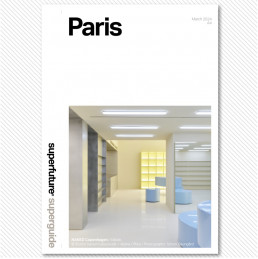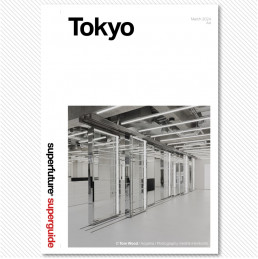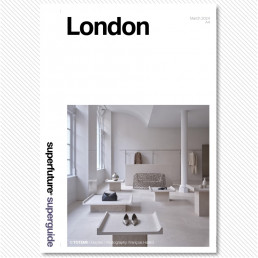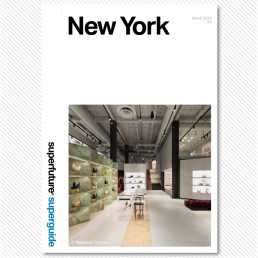
Having established an array of standalone boutiques in some of Europe’s most prominent markets, Aesop lacked such presence in the Netherlands. Well, that was yesterday. Following the roll-out of boutiques in Brussels and Antwerp, the Australian cosmetics brand has launched its latest design-led outpost in the Low Countries, situated on Utrechtsestraat in Amsterdam‘s scenic Canal District. Funnily enough, Aesop staff had been in touch with Superfuture many years ago where to set up shop, and our recommendations included the shopping thoroughfare where eventually its first standalone store in the city opened its doors. On the day of the official inauguration, we sat down with Thomas Buisson, General Manager Europe, for a chat about the store and the business, and perhaps just like us, rejoicing in this seemingly obvious full circle moment. Buisson’s colleague Pascale Thouzery (PT), the company’s Head of Marketing Europe, attended our meeting as well.
Why has it taken so long for Aesop to enter the Dutch Market?
(TB) Aesop is a thirty-year old brand, so from that perspective it isn’t that long. It’s good to take the time to do things well—to launch a market properly, to find the right location and also build it properly. We’re not rolling out a chain and opening in every city. The other reason is that we’ve always had a great presence in the Netherlands through our local wholesale partner Skins Cosmetics and therefore opening up shop here wasn’t a priority, but we always had it in the back of our mind. Also, we initially hesitated on the location of our first store here, despite your original advice*, but which we followed in the end. For a while we were searching for a location in the Nine Streets shopping area, but couldn’t find anything in the right spot and at the right price. And also, from an architectural perspective, we’ve now set new standards our stores should meet, meaning that they require certain measurements, and most were simply too small or had an awkward configuration.
Utrechtsestraat has always been on our radar, but compared to the Nine Streets area, it felt more touristic and residential, and more on the edge of town. If you look at the history how we built the brand and establishing the first store in a new market, and in the EU in particular, finding a really solid local base is the best way to start a business. If you’re relying only on tourists, and there are a lot of them in this city, then you don’t have that anchor business to ensure longevity. On top of that, the store opening process took much longer than we were anticipating because of the complexities of having to deal with a listed building. Initially, only the building itself was listed, but when we signed the lease, the interior became listed as well. We originally planned a radically different setting, but that suddenly was out of the question. But I think the result is an amazing blend of the talent of designer Valentin Loellmann and the structure’s original shell.
To which extent are you directly involved with the roll-out in new European markets, and could you elaborate on the timeline of events leading up to the opening of the first Amsterdam store?
(TB) I’ve always been quite involved, but these days I have someone who’s entirely devoted to scouting new locations. It’s generally a group effort. Where we open up shop is an important part of what we do, but it’s always preceded by a process in which actually a lot of people are involved. The two stores in Belgium opened prior to the launch of store in Amsterdam because of the real estate opportunities. We actually started looking around in Amsterdam, but weren’t able to secure the first location we found. I think there’s a lot of interest by new brands to settle here, making the market quite competitive. I mean, the city has architectural relevance, it’s affluent, many tourists, so generally it’s an attractive place from a retail perspective.
Could you elaborate on the collaboration process with various design practices and the selection procedure which precedes every store opening?
(TB) Over the years we’ve built a significant design team within Aesop. Originally, we wanted to work with local architects because of course we didn’t have a choice. Everything was all about forging a partnership with the brand. In the beginning only one person was involved in this and that was founder Dennis Paphitis. We’ve seen the opportunity to work with external talents as an extraordinary cross-fertilisation. It’s now very fashionable for brands to have differently designed stores, but for us it has been like this from the very beginning. Also, it wasn’t a marketing strategy, but it turned out to be one, generating a lot of interest from people who are into design, and interior design in particular because it’s an exercise in itself. I mean, how can you do the same thing 250 times differently? The partnership with all these external people turned out to be really fulfilling, and to this dat we continue this, but as you know we also do in-house design. There isn’t a specific procedure when when to collaborate with an outsider or when to have our own design team work on a store interior.
We’ve got a list of people we’d like to collaborate with and we’re also frequently approached, sometimes even by people who haven’t designed anything at all! Recently we opened a store in Vienna which was designed by an architecture student. He sent us a project and it was extraordinary, so we decided to work with him. As for Valentin, the designer of our first Dutch store, he’s someone we’ve been following for a while even though he’s technically not an architect. We met him at his workshop in Maastricht, myself and Jean-Philippe Bonnefoi, the head of design for the EU, and spent the day with him to find out if he’d be interested to design a store. Because what he designs is actually furniture and some of his pieces aren’t exactly functional, but have a sculptural quality. And as said, we sometimes we do the research ourselves, and for instance when we opened our shop in Oslo, my colleague Jean-Philippe simply contacted architecture practice Snøhetta to see if they were interested in meeting us. I didn’t have much hope they’d be interested, to be honest. I mean, it was like reaching out to Herzog de Meuron or something. But you know, when we arrived at their office, we were met by three architects who had prepared an incredible presentation and we immediately hit it off!
The appeal of Aesop‘s stores seems evident. How would you explain the way your retail spaces resonate with your clientele?
(TB) I don’t think all of our customers are on the same wavelength as we are in terms of architecture and design, some don’t even notice that we have a different design concept for each store. They do think our stores are beautiful, but interestingly, they wouldn’t be able to define what makes each of them different. To a certain degree it’s part of our success, because as a brand you also need to be recognised first and foremost for your products and the way of merchandising, and ours is very much so.
(PT) A lot of our customers don’t even know how big Aesop is and think that the store where they shop in their neighbourhood is the only one, simply because they feel the store belongs there and think we arrived there without changing much to the setting. For them it’s about a feeling of proximity, a feeling of belonging.
(TB) It’s something that is very relevant in the current commercial urban landscape, but there’s also an almost desperate effort to be relevant. Everyone is trying so hard to be relevant and provide an exceptional experience, forgetting about the basic simple things such as being recognised when you’re a regular client. Don’t go to the latest cool store which has a screen which transforms you, making you ten years younger. That’s not retail. Retail is about making a human connection and about the fact that you buy from someone who knows you, what you like, and remembers what you bought last week. At Aesop, we’ve established a connection with the people who work for us in the stores, the architects we collaborate with, the community around us. If you do retail well, there’s no need to constantly reinvent the wheel. At Aesop we try to build teams of people who contribute something in interactions and are able to build relations, who are receptive of their surroundings, they need to have a certain level of curiosity.
How would you describe the profile of the Aesop client and has it evolved over the years?
(TB) I think there’s different levels of reading the Aesop brand, depending on the life experience you have or culture you’re from. You know, Dennis Paphitis has always thought of Aesop as a democratic company. From a pricing perspective we’re not demonstrating wealth, but price for us is a consequence of the ingredients of a product and never as a consequence of brand positioning. So yes, we’ve got this connection with architecture, literature and music, and we’d like to use all that as an opportunity to bring something to our customers, but if they don’t want it and just the product, that’s just fine. Everyone sees and experiences something different, it doesn’t need to be a one size fits all. And also, I think it’s good we’re able to change people by exposing them to something they haven’t been exposed to before. So, if you take a look at the Aesop newsletters, they aim to elevate people, and not necessarily sell them something.
How do you view Amsterdam‘s retail landscape and do you see room for growth for Aesop in the Netherlands?
(TB) Well, what I’ve seen, as in many other big cities, is that there’s a very commercial centre which sadly is a replication of what you see elsewhere, so a lot of chain stores and high foot traffic. We as Aesop don’t feel comfortable there. What has remained in Amsterdam, and it’s something I really like, is a substantial number of independent and interesting stores. Although this specific segment is fading, just like everywhere else, I think the situation right now is not too bad. It’s tough for them, because landlords these days can be quite harsh. As for expansion in the Netherlands, there are no immediate plans, but we’re just exploring the market. You know, we also opened a counter at de Bijenkorf department store here in Amsterdam. Elsewhere, we have a presence through Skins Cosmetics. But obviously, both the new store and counter will enhance our visibility in this country.
You have witnessed the purchase of Aesop by Brazilian beauty giant Natura in 2012. Could you shed light on how it has effected operations at Aesop the synergetic advantages spawning from the deal?
(TB) I’m asked this question many times. To begin with, both companies have a very different scale, Natura‘s annual turnover is EUR 3 billion. From sustainability and social perspective, it’s an incredible company, and frankly, i had no idea in the beginning. At a business level for Aesop, I think the level of respect and intelligence with which they treated this investment is remarkable. They’ve been supportive, but also hands-off as well. You probably know that the Natura group also includes The Body Shop, an organisation with bigger teams within the EU, and sometimes we’re able to use a lawyer from them. For instance, we’re looking at entering a new market and they already have a subsidiary there. So, they also introduce us to local real estate agents. It’s that kind of synergy, but with an absolute respect for the integrity of the Aesop brand. The culture at Natura is in fact all about building meaningful relationships and that’s what they also did with Aesop.

Publishers Note
Just to be clear – superfuture® is a design blog and not a political commentator. No surprise there. The scope of our content has always been global and borderless, however that can often mean covering projects in countries where we will not agree with the politics or actions of those countries. In a world that’s as screwed up as ever right now, the focus of our support is to those designers, architects and other creatives who aim to make the world a more liveable one – as opposed to people that try their hardest to destroy it. So if a project hits our desk and we like it based on its design credentials, we may choose to publish regardless of its location or creators nationality. superfuture® has always been inclusive and hopes for all current wars, aggression, violence, hate and extremism to end.





